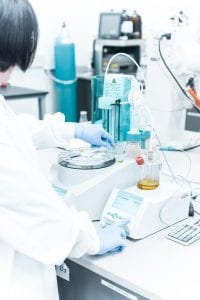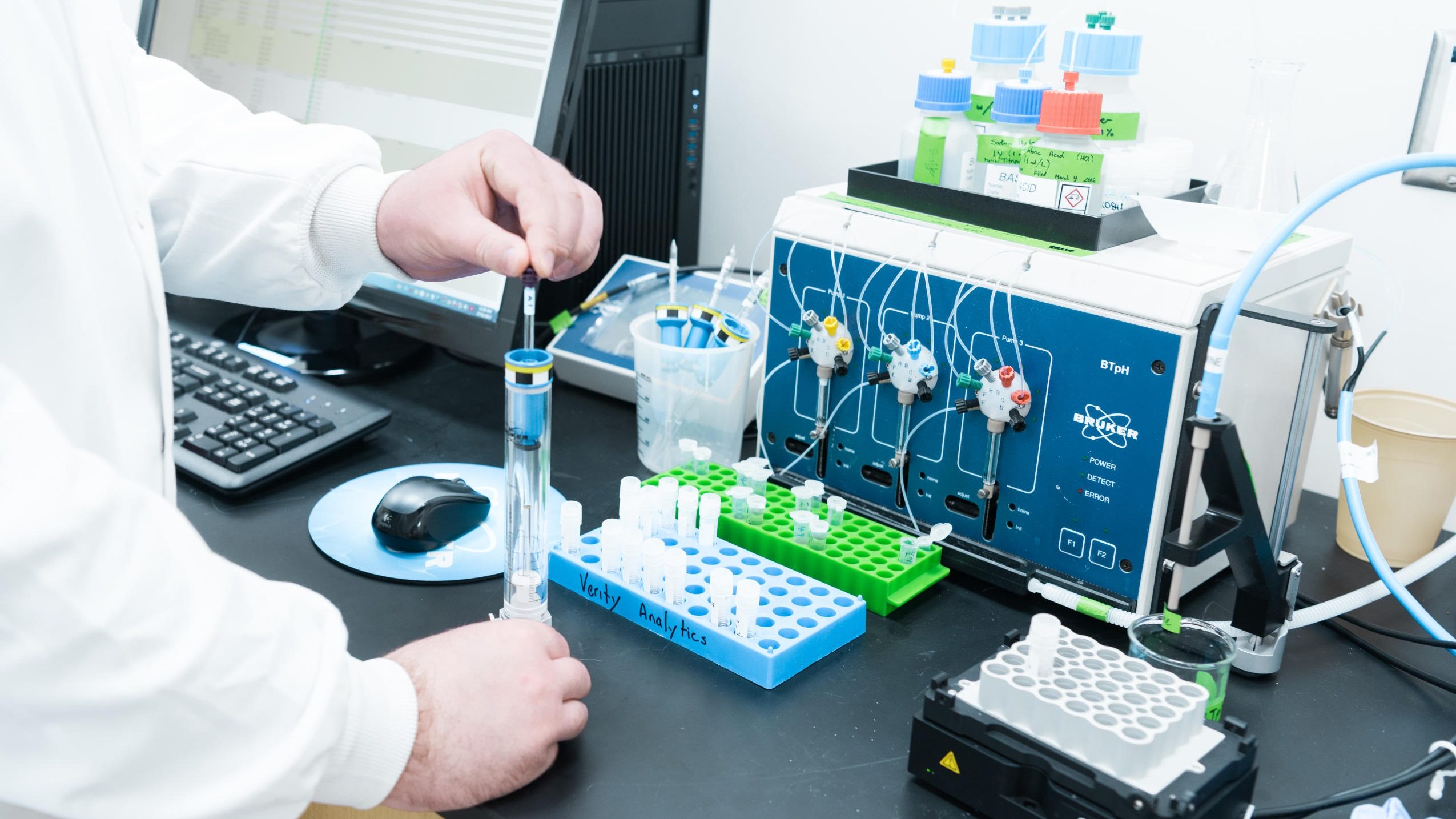THC. CBD. Indica. Sativa. If you’ve been paying attention to the discussion around cannabis legalization in Canada, you may have heard some of the jargon. If you’ve ever been inside a cannabis dispensary, you may even know what some of it means. The problem is, there isn’t a whole lot of cannabis research out there.
As the Canada Research Chair for Phytoanalytics (the study of plant-based medicines), Dr. Paula Brown knows a thing or two about cannabis. Within the BCIT Centre for Applied Research (CARI), Paula and her team are essentially drafting an open-access instruction manual that will guide research around this very misunderstood plant.
“With hundreds of strains, growing conditions, and human interventions – cannabis can run the gamut in terms of efficacy, potency, and medicinal benefit,” says Paula. And that doesn’t even take into account user consumption method (smoking, vaping, ingesting, etc.).
Information on strains vary from dispensary to dispensary, and as cannabis is still considered a controlled substance, North American research on strains is limited. Not to mention that cannabis has been subject to such extensive human intervention, that current strains are no longer traceable to any wild type.
Going beyond sativa vs. indica
To understand the importance of Dr. Brown’s cannabis research, you have to first understand the current buyers’ market.
In broad strokes, when considering a cannabis purchase, users can usually expect to learn whether the plant is a Cannabis indica or Cannabis sativa strain.
“What most people will tell you, is that sativa is a more uplifting strain,” says Amanda Siebert, Cannabis Editor for the Georgia Straight. “If you’re using cannabis during the day, you’re probably going to stick to sativa or a sativa-dominant blend, whereas an indica would be something you would be using for pain-relief or to fall asleep. But it’s important to acknowledge that one strain could affect two people in completely different ways.”
But this general categorization – sativa vs. indica – is only the tip of the iceberg when it comes to identifying what strain will meet a user’s needs. “Because of the kind of work that Paula’s doing, the school of thought has morphed from the indica/sativa thing, into something far more specific,” says Siebert.
As one of the first Cannabis Editors for a mainstream publication in Canada, Siebert guides readers through the enormous variety of cannabis information (and misinformation) currently on the market. She also reviews cannabis products for the weekly magazine – providing tasting notes, flavor profiles, and producer backgrounders.
Siebert will look for levels of THC (tetrahydrocannabinol – the compound responsible for the euphoria or “high” associated with cannabis), as well as CBD (cannabidiol – a compound associated with the medicinal, and non-psychoactive, aspects of cannabis). Occasionally this important information is provided by the producer or dispenser, but as Siebert will tell you, these are only two compounds out of hundreds that form the framework of the cannabis plant.
“Sativa/indica doesn’t give you enough information, and THC/CBD levels aren’t an accurate representation of the chemical make-up of cannabis,” says Dr. Brown.
The whole plant picture

To get the full map of the plant, Dr. Brown and her team use sophisticated nuclear magnetic resonance technology to identify the nuanced compounds that make up various cannabis samples. Some of these compounds (called terpenes) can be identified by smell and flavor.
Siebert has her own “follow-your-nose” approach when it comes to terpenes. “When you smell a plant— let’s say we’re smelling lavender—that familiar and calming scent comes from a terpene called Linalool,” says Siebert. “Linolool can be found in cannabis and has been linked to relief from stress, anxiety, and depression.”
There are hundreds of terpenes that can be found in cannabis – each with their own individual healing properties. Unfortunately, in this current unregulated dispensary market, there are also plants being sold that are tainted with pesticides and toxins as a result of individual producer’s growing processes. These toxins are understandably worrisome for any user – especially medicinal users.
As Canada moves closer to recreational cannabis legalization, Dr. Brown hopes that testing of cannabis products becomes more consistent and comprehensive to ensure the safety, efficacy, and quality of products across the country.
“With our cannabis research, we are able to go beyond smell or taste and create a fulsome plant profile,” says Dr. Brown. “Using novel approaches and validated methods will lead to better therapeutic results for the end user.”
By characterizing the cannabis metabolome (breaking down cannabis at a base level) and validating testing methods to evaluate the plant, Dr. Brown and the BCIT Natural Health and Food Products Research Group (NRG) are developing the industry-standard tools that governments, producers, and scientists will need to fully understand this complex plant.
Real-world learning
Today, Dr. Brown and her team continue to share their validated cannabis research methods online, at conferences, and within the research community. They are also actively investigating new partnerships with licensed producers and other researchers who have shared interests in exploring unique chemotypes and supporting improved quality control across the board.
Since late last year, Dr. Brown has been working with Teewinot Life Sciences Corporation, focusing on the research behind enzymes that are derived from cannabis for pharmaceutical purposes. “Dr. Paula Brown and BCIT have been critical to further our research of cannabinoid pharmaceuticals. The powerful tools her lab possess have aided in the confirmation of our research and furthered our research through the discovery of new compounds,” says Mingyang Sun, Vice President of Teewinotlabs. This kind of industry connection is what sets BCIT research apart from traditional post-secondary research.
Dr. Brown and her team have also brought invaluable learning to students in this exciting and challenging field. In their state-of-the-art lab, NRG provides students with specialized training in the chemistry and analysis of natural health products – an opportunity not currently available from any academic institution in Canada. NRG provides co-operative (or Work Integrated Learning) placements for students from a range of programs – including Biotechnology, Chemical and Environmental Technology, and Food Technology. The mentorship and hands-on education that NRG provides to students is paramount to their future success.
About the BCIT Centre for Applied Research (CARI)
Based in Burnaby, BC, CARI works with business and industry to develop innovative solutions in a wide range of research areas. BCIT researchers have developed hundreds of practical solutions to industry challenges across Canada. Drawing on faculty from more than 200 technical programs within BCIT, the full-time research staff of the Applied Research groups MAKE+, SMART and NRG, and the applied research and development experts in our Applied Research Liaison Office, we can assemble project teams with multi-disciplinary skills and expertise. Research projects conducted at BCIT typically involve:
- Design and development of prototype devices, systems and applications
- Analysis, testing and evaluation of new technologies
- Commercialization and licensing of new technologies and products
BCIT research clients range from independent entrepreneurs with unique prototype ideas, to multi-national companies and organizations developing new products and services.
If you have a potential research project or idea and would like to explore the possibility of working with BCIT, please contact our Applied Research office.
If you’re interested in partnering with Dr. Brown, please contact BCIT Natural Health and Food Products Research Group.
If you are a member of the media and would like to learn more, please contact Jocelyne Leszczynski, Media and Communications Specialist

Great research! I’m a pro cannabis!
The high tech research laboratory in Vancouver is aided in the confirmation of the research to explore and discover the cannabis new compounds, so I think their technology in researching was so very innovative.
It’s a good thing that the research laboratory in Vancouver has used its purpose. It is very helpful to explore new inventions and discoveries. By using their high technology materials it is possible to reach its goals.